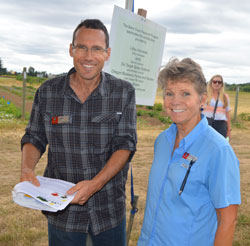Sawdust Proving Beneficial in Weed Mat Trial
Findings from the second fruiting-year of a study at Oregon State University’s North Willamette Research and Extension Center into the use of weed mat mulches in blueberries showed similar results from the first fruiting season, with sawdust again playing a key role.
 |
Oregon State University Extension Berry Specialist Bernadine Strik, pictured with OSU entomologist Vaughn Walton at the 2019 Oregon Blueberry Field Day in Aurora, unveiled research findings showing that sawdust under weed mat provides several benefits over weed mat used alone in blueberry production systems. |
Launched in part to study the decline in organic matter that the Berry Research Program found when using weed mat mulches in a ten-year organic blueberry study, the trial is showing several advantages to applying sawdust under both green and black weed mats.
Although the decline in organic matter never got to the point where it affected yield, the concern is that levels could eventually get too low and have negative effects on yield and quality, according to lead researcher Bernadine Strik, a professor at Oregon State University.
While still early in the study, results to date are suggesting that applying sawdust under the weed mat can slow the decline in soil organic matter by moderating the increase in soil temperature that results from long-term use of weed mat.
“It really is moderating that soil temperature,” Strik said during a presentation at the 2019 Blueberry Field Day, July 17 in Aurora. “So, I wouldn’t expect organic matter to decline as quickly under those weed mat treatments (that include sawdust).”
Slowing the decline in organic matter is just one of several benefits Strik and her team are finding in what she is calling the “weed mat color plot.” The study, which is measuring the effect of different colors of weed mat, plus use of sawdust alone and under the weed mats on plant growth, yield and several other factors, is showing that use of sawdust under weed mat is increasing root, plant growth and yield, while having no negative effect on quality.
“Over two fruiting seasons, during establishment, adding sawdust underneath black weed mat increased our yield by 0.7 ton per acre,” Strik said.
And, she said, vole pressure, which can increase when using weed mat because the mat provides cover from predators, is reduced when applying sawdust under the mat.
“Voles don’t like sawdust,” Strik said. “We have significantly lower vole presence under green weed mat with sawdust than green alone, and under black with sawdust than under black alone.”
Strik also pointed out that plants in the plots where sawdust is under weed mat had a bigger root system than plants under weed mat alone. She attributed this to the decrease in soil temperature that sawdust provides.
“What else could that be besides temperature, when they are being fertilized the same and being irrigated to meet plant demand,” she said.
The trial was planted to the Duke variety in October of 2016 and pruned to remove any fruit present on the plants in their first growing season, 2017. Douglas-fir sawdust is being used in the trial.